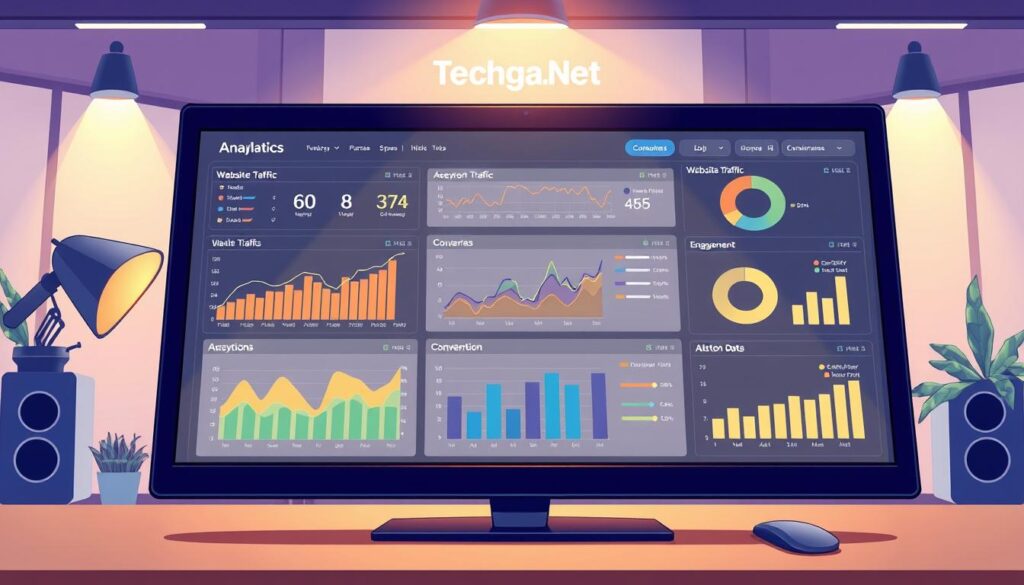In today’s fast-paced digital landscape, understanding user behavior is crucial for success. Every click, scroll, and interaction tells a story. By decoding these patterns, businesses can uncover valuable insight that drives growth.
Digital tools act as a sleuth, transforming raw datum into actionable strategies. Platforms like Google Analytics reveal hidden trends, helping companies make informed choices. This process sets the foundation for sustainable progress.
Integrating these insights into every aspect of operations ensures efficiency. From marketing to product development, the right information empowers teams to act swiftly. This approach not only boosts productivity but also enhances customer satisfaction.
In this guide, we’ll explore practical techniques to unlock the potential of digital tools. We’ll also highlight emerging trends and real-world examples from leading brands. Let’s dive in and discover how to turn data into growth.
Key Takeaways
- Digital tools decode user behavior to reveal actionable insights.
- Platforms like Google Analytics uncover hidden trends.
- Transforming raw data into strategies drives business growth.
- Integrating insights improves efficiency across operations.
- Practical examples from leading brands highlight success.
Ecommerce Development in 2025: Trends and Future Growth
By 2025, ecommerce will be transformed by cutting-edge advancements. Emerging technologies like AI, real-time insights, and predictive tools are reshaping the industry. These innovations are not just trends—they’re the foundation for future growth.
Emerging Technologies Transforming Ecommerce
Artificial Intelligence is at the forefront of this evolution. AI-powered tools are enabling personalized shopping experiences, analyzing browsing patterns to recommend products. For example, Netflix uses AI to suggest content, while Corel Software leverages predictive tools to enhance user engagement.
Real-time insights are another game-changer. Businesses can now monitor customer behavior instantly, adjusting strategies on the fly. This agility ensures they stay competitive in a fast-paced market.
Anticipating Future Growth Opportunities
The ecommerce sector is poised for significant expansion. By 2025, global sales are projected to reach $7.4 trillion. Mobile commerce will play a crucial role, accounting for 44% of U.S. sales.
Brands that adopt advanced technologies early will gain a competitive edge. From AI chatbots to predictive inventory systems, these tools streamline operations and boost customer satisfaction. Staying ahead of these trends is key to unlocking new opportunities.
Leveraging Website Analytics and Data-Driven Decision Making
Understanding customer behavior is the cornerstone of effective strategy. By tracking key metrics, we gain clarity on how users interact with our platforms. This insight helps us refine our approach and achieve set goals.

Metrics like bounce rates, conversion rates, and session duration are critical. They reveal patterns in user engagement, guiding strategic choices. For example, a high bounce rate may indicate issues with page relevance or load speed.
Structured analysis ensures our organization stays aligned with its objectives. By monitoring these indicators, we can optimize marketing efforts and streamline the customer journey. This approach not only boosts efficiency but also enhances satisfaction.
Key Metrics for Informed Decisions
Conversion rates are a vital measure of success. They show how effectively we turn visitors into customers. Similarly, session duration reflects user interest, helping us identify engaging content.
Bounce rates provide a snapshot of first impressions. A low rate suggests a positive experience, while a high rate signals room for improvement. These metrics empower us to make real-time adjustments.
By leveraging data insights, we can drive precise, informed choices. For instance, leveraging data insights has helped many organizations enhance their decision-making processes. This practice ensures we stay competitive in a dynamic market.
Integrating Website Analytics into Business Strategy
Strategic integration of insights is the backbone of modern business growth. By aligning these insights with clear objectives, we can optimize operations and enhance user experience. This approach ensures measurable impact across all areas of our strategy.

Aligning Data Insights with Business Objectives
To achieve success, we must first define our goals. Whether it’s increasing conversion rates or improving customer satisfaction, insights provide the roadmap. Tools like Google Analytics offer real-time data, helping us stay on track.
Here’s how we can align insights with objectives:
- Identify Key Metrics: Focus on indicators like bounce rates and session duration to gauge performance.
- Set Clear Targets: Establish measurable goals, such as reducing bounce rates by 15%.
- Monitor Progress: Regularly review dashboards to ensure alignment with business goals.
By following these steps, we can refine our strategy and drive growth. For example, leveraging insights effectively has helped many organizations outperform competitors.
Improving User Experience and Performance
Enhanced experience is a direct result of strategic integration. By analyzing user behavior, we can identify pain points and address them promptly. This not only boosts satisfaction but also improves overall performance.
Consider the following table to understand the impact of insights:
| Metric | Impact | Action |
|---|---|---|
| Bounce Rate | High rates indicate poor relevance or slow load times. | Optimize page content and speed. |
| Conversion Rate | Low rates suggest ineffective calls-to-action. | Refine CTAs and landing pages. |
| Session Duration | Short durations may signal unengaging content. | Enhance content quality and relevance. |
By mapping insights to decision-making models, we can drive precise, informed choices. This practice ensures we stay competitive in a dynamic market.
Driving Actionable Insights from User Data
Every piece of data holds the potential to shape smarter strategies and better outcomes. By transforming raw information into actionable insights, we can unlock significant business potential. This process involves careful analysis, strategic thinking, and a focus on enhancing customer experience.

From Raw Data to Strategic Decisions
The journey from raw data to strategic decisions begins with identifying key patterns. For example, Starbucks uses location analytics to determine the success of new store locations. By analyzing demographic and traffic patterns, they make informed choices that drive growth.
Here’s a step-by-step approach to this transformation:
- Collect Data: Gather information from various sources, such as user interactions and sales metrics.
- Analyze Patterns: Look for trends that reveal user behavior and preferences.
- Set Objectives: Define clear goals based on the insights gained.
- Implement Strategies: Use the data to refine content and marketing tactics.
Enhancing Customer Experience
Analyzing user behavior helps us identify pain points and improve satisfaction. For instance, Amazon’s recommendation system accounts for 35% of its consumer purchases. By understanding user preferences, they deliver personalized experiences that drive conversions.
Key steps to enhance experience include:
- Monitor Engagement: Track metrics like session duration and bounce rates.
- Tailor Content: Adjust content to meet user needs and preferences.
- Optimize Platforms: Ensure seamless navigation and fast load times.
By leveraging tools like affordable web analytics, we can gain deeper insights into user behavior. This allows us to make informed decisions that boost performance and satisfaction.
Navigating Cutting-Edge Technologies in Ecommerce
The ecommerce landscape is evolving rapidly, driven by innovative technologies. These advancements are not just trends—they’re reshaping how businesses operate. From advanced tools to future trends, the focus is on enhancing customer experiences and driving growth.

Advanced Analytics Tools for Ecommerce
Tools like Google Analytics and Adobe Analytics are central to modern strategies. They provide real-time insights, helping businesses anticipate market shifts. For example, Netflix uses predictive tools to recommend content, boosting engagement.
These platforms enable the extraction of meaningful information from vast data amounts. By analyzing user behavior, companies can refine their strategies. This process ensures they stay competitive in a dynamic market.
Future Trends in Ecommerce Tech
AI and machine learning are at the forefront of future trends. These technologies enable personalized shopping experiences, increasing customer satisfaction. For instance, Amazon’s recommendation engine accounts for 35% of its sales.
Predictive tools are another game-changer. They optimize inventory management, reducing waste and improving profitability. By adopting these innovations early, businesses can secure a competitive edge.
| Technology | Impact | Example |
|---|---|---|
| AI-Powered Recommendations | Boosts engagement and sales | Amazon’s personalized suggestions |
| Predictive Analytics | Optimizes inventory levels | Zara’s trend forecasting |
| Real-Time Insights | Enables agile decision-making | Netflix’s content recommendations |
By leveraging these tools and trends, businesses can drive success in the ecommerce space. The key lies in staying informed and adapting to emerging technologies.
Enhancing Marketing Campaigns with Data-Driven Insights
Modern marketing thrives on precise insights that shape impactful strategies. By integrating these insights, we can refine campaigns, boost engagement, and achieve measurable results. This approach ensures every effort aligns with audience needs and preferences.

Optimizing Campaign Performance
Effective campaigns rely on real-time tracking and precise targeting. Monitoring key metrics like click-through rates and engagement levels helps us adjust strategies swiftly. For example, companies like Netflix use real-time data to refine their content recommendations, driving higher user engagement.
Here’s how we optimize performance:
- Track Metrics: Monitor indicators like conversion rates and bounce rates to gauge success.
- Adjust in Real-Time: Use insights to tweak campaigns for better results.
- Focus on ROI: Ensure every effort contributes to measurable growth.
Tailoring Content Based on Analytics
Personalized content resonates deeply with audiences. By analyzing browsing patterns and preferences, we can craft messages that truly connect. For instance, Amazon’s recommendation engine drives 35% of its sales by tailoring suggestions to individual users.
Key steps to tailor content include:
- Analyze Behavior: Understand what drives user engagement.
- Segment Audiences: Group users based on shared characteristics.
- Deliver Relevance: Create content that meets specific needs.
This trend of personalization is reshaping the marketing landscape. Companies that embrace it see higher engagement and conversion rates. For example, personalized campaigns can increase conversions by up to 10 times compared to generic approaches.
| Strategy | Impact | Example |
|---|---|---|
| Real-Time Tracking | Boosts campaign agility | Netflix’s content recommendations |
| Personalized Content | Increases engagement | Amazon’s recommendation engine |
| Audience Segmentation | Improves targeting precision | Zara’s trend forecasting |
By leveraging these strategies, we can drive impactful marketing campaigns. The key lies in using insights to guide every decision, ensuring our efforts are both effective and efficient.
Maximizing Website Performance with Real-Time Analytics
Real-time insights are transforming how we monitor and optimize online presence. By leveraging live data, we can address issues instantly and ensure a seamless user experience. This approach keeps us agile and responsive in a fast-paced digital environment.
Monitoring Key Performance Indicators
Tracking key metrics is essential for maintaining optimal performance. Metrics like bounce rates, session duration, and conversion rates provide valuable insights into user behavior. For example, a sudden spike in bounce rates may indicate technical issues or irrelevant content.
Immediate action based on these insights can prevent potential bottlenecks. By identifying and resolving issues quickly, we enhance user satisfaction and retention. This proactive approach ensures our platform remains efficient and user-friendly.
Here’s how we leverage real-time data effectively:
- Continuous Monitoring: Track live metrics to detect anomalies instantly.
- Quick Adjustments: Use insights to refine content and improve load times.
- Enhanced Experience: Address user pain points to boost engagement.
By integrating these strategies, we maintain a high-performing online presence. Real-time analytics not only improve performance but also guide our decision-making process. This ensures we stay ahead in the competitive digital landscape.
Uncovering Conversion Roadblocks Through Data Analysis
Identifying and addressing friction points in the customer journey is essential for boosting conversions. By carefully analyzing user interactions, we can pinpoint exactly where visitors drop off. This understanding enables targeted improvements that streamline the path to conversion.
Our team uses advanced systems to track every step of the customer journey. From initial clicks to final purchases, we gather data that reveals hidden bottlenecks. This process helps us identify specific roadblocks that hinder progress.
Identifying Bottlenecks in the Customer Journey
One common issue is a high bounce rate on key pages. For example, if 60% of visitors leave on the pricing page, it may indicate unclear information or slow load times. By addressing these issues, we can significantly improve engagement.
Here’s how we tackle these challenges:
- Analyze Behavior: Use session replays to identify user struggles, such as hesitation on form fields.
- Segment Users: Group visitors based on behavior to tailor solutions for each segment.
- Optimize Content: Refine messaging and design to reduce friction and guide users effectively.
The impact of these changes is measurable. For instance, one of our clients saw a 25% increase in conversions after optimizing their checkout process. This success highlights the power of data-driven improvements.
By leveraging insights from tools like professional eCommerce design, we ensure every step of the journey is seamless. This approach not only boosts conversions but also enhances overall customer satisfaction.
Ensuring Data Quality for Reliable Decision-Making
High-quality data ensures reliable and actionable insights. Without it, even the best strategies can falter. Poor data quality costs businesses millions annually, making it a critical need for success.
To address this, we focus on strict validation and cleansing processes. These steps eliminate duplicates, ensure accuracy, and maintain consistency. By doing so, we create a foundation for informed choices.
Implementing Data Validation and Cleansing
Data validation is the first step in ensuring accuracy. It involves checking for errors, inconsistencies, and missing values. This process helps us identify and correct issues before they impact decisions.
Cleansing goes a step further by removing redundant or irrelevant data. For example, duplicate customer records can skew analysis and lead to flawed strategies. By standardizing formats, we ensure uniformity across all sources.
Here’s how we approach this:
- Eliminate Duplicates: Remove redundant entries to maintain accuracy.
- Standardize Formats: Ensure consistency in data collection and storage.
- Verify Sources: Cross-check data to confirm its reliability.
These practices not only improve data quality but also enhance the effectiveness of marketing campaigns. Clean data provides precise insights, enabling targeted strategies that resonate with audiences.
The Role of Visualization Tools
Data visualization tools play a crucial role in presenting clean, actionable information. They transform complex datasets into easy-to-understand visuals, helping teams make informed decisions quickly.
For instance, dashboards can highlight trends and anomalies, guiding strategy adjustments. By leveraging these tools, we ensure that insights are accessible to all stakeholders.
Maintaining high data quality is not just a solution—it’s a necessity. It empowers us to drive impactful strategies and achieve consistent results. By prioritizing validation and cleansing, we build a foundation for long-term success.
Integrating AI and Predictive Analytics in Your Strategy
AI and predictive analytics are reshaping how businesses operate in dynamic markets. These technologies offer a powerful approach to transforming raw data into actionable insights. By leveraging AI tools, we can uncover patterns and trends that drive smarter strategies.
Leveraging AI for Rapid Data Insights
AI plays a pivotal role in automating analytical tasks. It processes vast datasets quickly, providing real-time insights that keep us agile. For example, AI-powered tools can analyze customer behavior to predict future trends. This application helps us stay ahead of market shifts.
Predictive analytics takes this a step further. It uses historical data to forecast outcomes, improving strategic planning. Retailers, for instance, use it to optimize inventory levels and reduce costs. This opportunity ensures we make informed decisions with confidence.
Here’s how AI and predictive analytics enhance our approach:
- Automate Analysis: AI tools process data faster than manual methods, saving time and resources.
- Forecast Trends: Predictive models identify patterns, helping us anticipate market changes.
- Improve Accuracy: By minimizing human error, these tools deliver precise insights.
Real-world examples highlight their impact. Netflix uses AI to recommend content, boosting engagement. Similarly, Amazon’s predictive engine drives 35% of its sales. These applications demonstrate the transformative power of AI.
Integrating these tools opens new opportunities for efficiency. From marketing to supply chain management, AI-driven insights streamline operations. This approach not only enhances performance but also ensures long-term success.
Overcoming Organizational Challenges in Data Adoption
Adopting data-driven strategies often comes with its own set of challenges. From skill gaps to resistance, organizations must navigate these hurdles to unlock the full potential of their data. By addressing these issues head-on, we can create a culture that thrives on insights and drives growth.
Bridging the Talent and Skill Gap
One of the most common obstacles is the lack of skilled professionals. Many teams struggle to interpret data effectively, limiting its impact. To bridge this gap, we recommend investing in targeted training programs. These initiatives empower employees to leverage tools and make informed decisions.
Allocating the right resources is equally important. Providing access to advanced tools and platforms ensures teams can extract meaningful insights. For example, companies like Netflix and Amazon have built success by equipping their teams with the necessary skills and tools.
Managing Change and Resistance
Resistance to change is another significant barrier. Employees may feel overwhelmed by new processes or fear their roles becoming obsolete. To address this, we focus on clear communication and fostering a culture of collaboration. Highlighting the benefits of data-driven strategies helps ease the transition.
Creating a structured campaign to promote data literacy can also reduce resistance. Workshops, webinars, and hands-on training sessions make the shift more manageable. By involving employees in the process, we ensure they feel valued and supported.
Here are actionable steps to overcome these challenges:
- Invest in Training: Develop programs to enhance data literacy across teams.
- Allocate Resources: Provide tools and platforms for effective data analysis.
- Communicate Benefits: Highlight how data insights improve the customer journey and overall performance.
- Foster Collaboration: Encourage cross-departmental teamwork to share knowledge and insights.
By addressing these challenges, organizations can fully embrace data-driven strategies. This approach not only improves efficiency but also enhances the customer journey, leading to long-term success.
Real-World Success Stories in Data-Driven Growth
Real-world examples often provide the clearest path to understanding success. Leading ecommerce brands have harnessed the power of data to achieve remarkable growth. Their stories offer valuable lessons for businesses aiming to transform their strategies.
Lessons from Leading Ecommerce Brands
Netflix is a prime example of leveraging actionable insights. By analyzing viewing patterns, they recommend content that keeps users engaged. This strategy has led to a 93% retention rate, significantly higher than competitors.
Amazon’s recommendation engine is another success story. It accounts for 35% of their annual sales by tailoring suggestions to individual users. This approach aligns with their business objective of enhancing customer satisfaction.
Corel Software uses predictive tools to optimize user engagement. By understanding customer behavior, they’ve improved product performance and driven revenue growth. These examples highlight how actionable insights can transform business objectives into measurable success.
| Brand | Strategy | Outcome |
|---|---|---|
| Netflix | Content recommendations based on viewing patterns | 93% retention rate |
| Amazon | Personalized product suggestions | 35% of annual sales |
| Corel Software | Predictive tools for user engagement | Increased revenue |
These success stories serve as a blueprint for businesses. By adopting data-driven strategies, companies can enhance customer satisfaction and achieve long-term growth. The key lies in aligning actionable insights with clear business objectives.
Conclusion
In the evolving world of ecommerce, staying ahead requires more than just intuition. Leveraging actionable insights has become the cornerstone of sustainable growth. For enterprises, integrating robust tools is not just an option—it’s a necessity to maintain a competitive edge.
Throughout this guide, we’ve explored strategies that transform raw information into powerful growth drivers. From understanding user behavior to optimizing product performance, these methods ensure efficiency and innovation. Tools like Google Analytics and AI-powered platforms have proven their worth in real-world applications.
Continuous learning and adaptation are vital. As markets evolve, so must our approaches. By embracing these insights, enterprises can unlock new opportunities and drive lasting success. Let this guide serve as your roadmap to navigating the dynamic ecommerce landscape.
Adopt these strategies today. Stay agile, stay informed, and watch your enterprise thrive.



